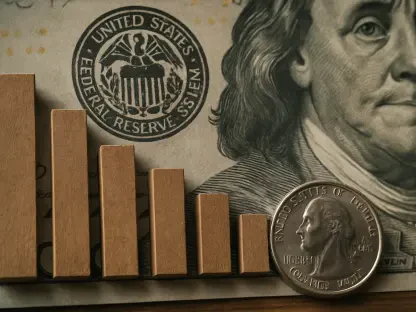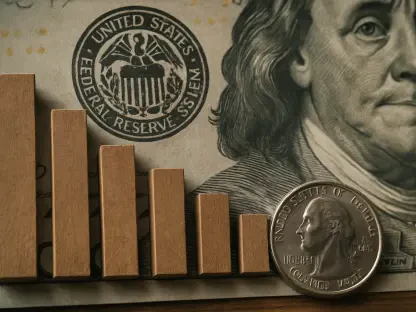In an era where global trade dynamics are often at the forefront of economic policy debates, the role of tariffs as a regulatory measure is particularly significant. In the United States, the imposition of tariffs has been a subject of intricate examination, especially concerning their impact on inflation and the production costs for businesses. Tariffs, essentially taxes levied on imported goods, serve as both a tool for protecting domestic industries and a potential driver of increased costs across the economy. The effects of these taxes can ripple through various sectors, influencing consumer prices and altering the economic landscape. This analysis provides a comprehensive investigation into how recent tariffs, notably those at a uniform 25% rate on all imports, can affect inflation metrics and the cost structures within the U.S. economy.
The Mechanism of Tariffs and Their Economic Influence
Consumers and Investment Goods: Disparate Outcomes
Understanding the complex relationship between tariffs and economic indicators such as inflation and production costs necessitates a closer look at the distinct ways tariffs influence consumer and investment goods. On one hand, consumer goods face a relatively minor impact; on the other hand, investment goods bear a disproportionate burden. Statistics reveal an anticipated near-term price hike of roughly 9.5% for investment goods if a 25% tariff is entirely passed on, compared to a modest 2.2% rise for consumption goods. The core reason for this disparity is the higher import content within investment goods, which are crucial for business operations, such as machinery or components used in manufacturing.
Investment goods often rely heavily on imported raw materials and components. Consequently, tariffs increase their production costs, which businesses must absorb or pass along to consumers. This increase in production cost can manifest as decreased business investments and potentially stifled economic growth. For consumer goods, while many are domestically sourced, imported items face a price increase, albeit to a lesser extent. The difference in import reliance between these two categories explains the varying levels of impact tariffs have across sectors.
Import Content and Its Financial Implications
The examination of import content provides valuable insights into the financial implications of tariffs on various sectors. Despite widespread globalization, a significant portion of consumer goods in the U.S. is manufactured domestically, with imports comprising about 14% of the GDP. However, the real impact of these imports on consumer prices differs, thanks to additional domestic value, such as transportation and retail services reflected in the final selling price.
Investment goods, meanwhile, show that approximately 38% of their costs stem from imports. This contrasts starkly with consumer goods, which see only about 9% of their costs attributable to imports directly. Therefore, sectors heavily dependent on imports, such as those dealing with investment goods, experience greater vulnerability to tariff-induced cost fluctuations. Understanding these dynamics is essential for businesses in planning their cost strategies and investment decisions. For policymakers, these insights underscore the need to weigh tariffs’ protective domestic functions against their broader economic repercussions.
Broad Economic Implications of Tariffs
Consumer Price Index and Inflationary Trends
The effect of tariffs on consumer prices unfolds through changes observed in the Consumer Price Index (CPI), a major gauge for inflation. Tariffs that increase the cost of imports can lead to higher prices for goods and services in general. However, the extent of this impact can vary based on the sector and type of goods affected. Consumer goods, for instance, may experience relatively minor price adjustments, mostly in categories heavily reliant on foreign imports. In contrast, the implications for sectors like technology and manufacturing can be more significant.
Given that many investment goods have substantial import content, tariffs might notably shift the cost-base for producing such goods domestically. U.S. companies might pass these increased costs to consumers or halt new investments, affecting the sectors’ growth and output. Businesses grappling with higher equipment costs could see squeezed profit margins, which in turn may reduce hiring rates or lead to layoffs, subsequently influencing employment statistics and the broader economy.
Industrial Consequences and Business Strategy Adjustments
For industries deeply entrenched in global supply chains, tariffs can prompt a reevaluation of business strategies and cost-structure adjustments. Increased costs on imported goods due to tariffs can hinder industries that rely on intricate and international supply networks. Many businesses face the choice of absorbing higher costs, passing these costs to consumers, or shifting their supply chains to source materials domestically or from tariff-exempt countries.
For manufacturing and industrial sectors, tariffs can disrupt planned capital expenditures. As equipment and raw material costs rise, companies may delay or scale back on investments, which could slow down technological advancements and production efficiency improvements. Industries are forced to rethink not just production costs, but also product pricing strategies hoping to remain competitive in the marketplace. These shifts could culminate in a subsequent reshaping of U.S. industrial strategies, emphasizing innovation and competitive pricing while adapting to fluctuating trade regulations.
A Historical Perspective on Tariffs and Economic Protectionism
The Protective Facet of Tariffs in Historical Context
Historically, tariffs have held a dual role as both protective measures for domestic industries and instruments of economic influence. In various epochs, from the Smoot-Hawley Tariff Act in the 1930s to more recent tariff implementations, they have served to safeguard local industries against international competition. Such protection aims to foster local growth and employment within sectors threatened by cheaper foreign alternatives. However, these protective advantages often come with trade-offs, eliciting complex reactions from trading partners, including retaliatory tariffs.
These reactions can provoke a cycle of trade tensions, influencing global markets and complicating diplomatic relations. Retaliatory measures from trade partners could see U.S. exports suffering reduced competitiveness overseas. In a globalized economy, where interdependence among nations is profound, such trade disruptions pose significant economic challenges. Businesses, therefore, must remain vigilant, anticipating policy changes and adapting strategies to mitigate adverse impacts from evolving trade landscapes.
Policy Adaptations and Potential Outcomes
Navigating the intricate effects of tariffs necessitates careful policy consideration and proactive strategy from both businesses and governments. Policymakers must balance the protective aims of tariffs with potential detriments such as inflation and supply chain disruptions. In response to tariff impositions, businesses often need to diversify suppliers or seek innovations to reduce dependence on imported materials.
Adaptations might also involve investing in technology to enhance efficiency, offsetting increased material costs with productivity gains. Future scenarios predict that automation and advanced manufacturing techniques may evolve as central components in counteracting added costs. Deliberating on tariffs as a broader economic tool requires analyzing not just immediate fiscal impacts but also long-term strategic shifts in U.S. and global economic arenas. Overall, tariffs are foundational to understanding the trajectory of both economic policy and business strategy in a complex international framework.
The Path Forward for Tariffs and the U.S. Economy
As policymakers and businesses continue to navigate the evolving landscape of tariffs in the U.S. economy, it is crucial to focus on strategic adaptability and resilience against potential challenges. Recent tariff implementations underscore the importance of harmonizing protectionist policies with measures that mitigate adverse economic effects. Future considerations may involve innovations in supply chain management, increased focus on domestic technology enhancements, and exploring international partnerships to ensure competitiveness. While tariffs are designed to protect, thoughtful approaches to regulation might also emphasize economic synergy, promoting growth through collaborative global engagement. As the U.S. progresses, understanding the delicate balance between tariffs and their broader impacts remains vital to shaping informed policy decisions and sustaining economic vitality within an interconnected world.









